Singapore Changi Airport
| Singapore Changi Airport 新加坡樟宜机场 / 新加坡樟宜機場 Lapangan Terbang Changi Singapura சிங்கப்பூர் சாங்கி விமான நிலையம் | |||||||||||||||||||
|---|---|---|---|---|---|---|---|---|---|---|---|---|---|---|---|---|---|---|---|
 | |||||||||||||||||||
|
| |||||||||||||||||||
| Summary | |||||||||||||||||||
| Airport type | Public / military | ||||||||||||||||||
| Owner | Government of Singapore[1] | ||||||||||||||||||
| Operator | |||||||||||||||||||
| Serves | Singapore | ||||||||||||||||||
| Location | Changi, Singapore | ||||||||||||||||||
| Opened |
1 July 1981 (operational) 29 December 1981 (official) | ||||||||||||||||||
| Hub for | |||||||||||||||||||
| Focus city for | |||||||||||||||||||
| Time zone | SST (UTC+08:00) | ||||||||||||||||||
| Elevation AMSL | 6.66 m / 22 ft | ||||||||||||||||||
| Coordinates | 01°21′33″N 103°59′22″E / 1.35917°N 103.98944°ECoordinates: 01°21′33″N 103°59′22″E / 1.35917°N 103.98944°E | ||||||||||||||||||
| Website |
www | ||||||||||||||||||
| Map | |||||||||||||||||||
 SIN Location in Singapore 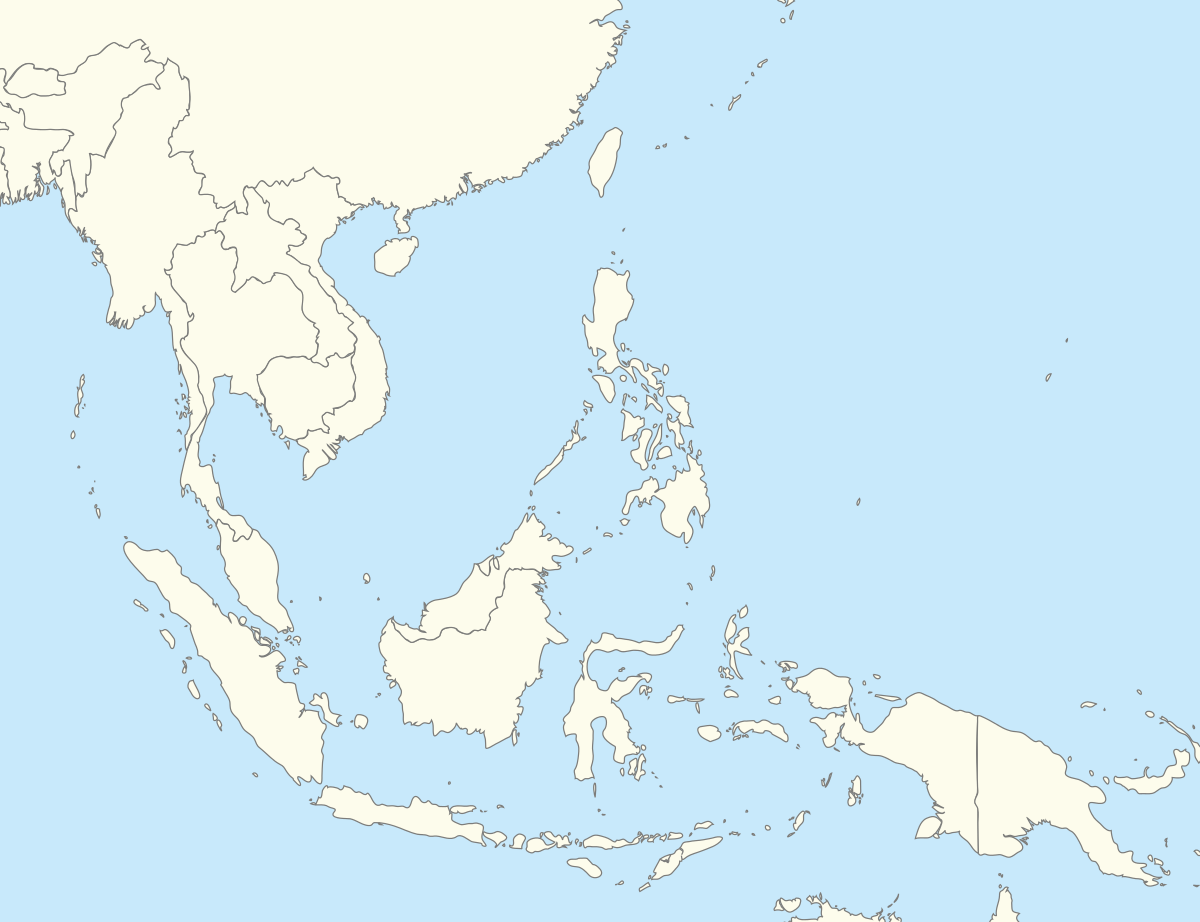 SIN SIN (Southeast Asia) | |||||||||||||||||||
| Runways | |||||||||||||||||||
| |||||||||||||||||||
| Statistics (2017) | |||||||||||||||||||
| |||||||||||||||||||
|
Source: Changi Airport Group[4] | |||||||||||||||||||
Changi Airport (IATA: SIN, ICAO: WSSS) is the major civilian airport for Singapore, and one of the largest transportation hubs in Southeast Asia. It is currently rated the World's Best Airport by Skytrax,[5] for the sixth consecutive year since 2013[6] and is one of the world's busiest airports by international passenger and cargo traffic. The airport is located in Changi, at the eastern end of Singapore, approximately 20 kilometres northeast[7] from Marina Bay (Singapore's Downtown Core), on a 13-square-kilometre (5.0 sq mi) site. It is operated by Changi Airport Group and it is the home base of Singapore Airlines, Singapore Airlines Cargo, SilkAir, Scoot, Jetstar Asia Airways and BOC Aviation.
Overview of Changi Airport

Changi Airport serves more than 100 airlines flying to 400 cities in around 100 countries and territories worldwide. Each week, about 7,200 flights land or depart from Changi, or, about one every 80 seconds.
For the 2017 full year figures published by the airport, the airport handled 62,219,573 passengers (a 6.0% increase over the previous year), the most in its 36-year history.[4] This made it the sixth busiest airport by international passenger traffic in the world and the second busiest in Asia. In December 2017, Changi Airport registered a total of 5.86 million passenger movements, the highest the airport has ever achieved in a month since it opened in 1981. Its daily traffic movement record was also broken on 22 December 2017, with 208,043 passengers passing through during that day. In addition to being an important passenger hub, the airport is also one of the busiest cargo airports in the world, handling 2.125 million tonnes of cargo in 2017. The total number of commercial aircraft movements increased by 3.1% from the previous year to 373,201 in 2017.[4] In April 2017, the airport handled more than a billion passengers for the first time.[8][9]
The airport has won over 557 awards since its opening, including 26 "Best Airport" awards in 2017 alone.[10] Changi Airport's efforts to mitigate the effects of ageing infrastructure include continual physical upgrades to its existing terminals and building new facilities to maintain its high standards in airport service quality.[11]
Passenger terminals
Changi Airport has four main passenger terminals arranged in an elongated inverted 'U' shape. Currently, the airport has a designed total annual handling capacity of 85 million passengers.
- Terminal 1, opened in 1981, is located at the northern end.
- Terminal 2, opened on 22 November 1990, is located at the eastern end.
- Terminal 3, opened on 9 January 2008, is located at the western end.
- Terminal 4, opened on 31 October 2017, is located on the southern side, at the site of the former budget terminal.
There is also a privately run luxury terminal called the JetQuay CIP Terminal. It is similar to the Lufthansa First Class Terminal at Frankfurt Airport, but is open to all passengers travelling in all classes on all airlines with an access fee.
Former terminal
The short-lived Budget Terminal was opened on 26 March 2006 and closed on 25 September 2012 to make way for a larger Terminal 4, which opened in 2017.[12]
Future terminals and projects
- Terminal 5 is set to be ready in the late 2020s. It is expected to handle 50 million passenger movements per annum.[13] The airport terminal structure is projected to be larger than all the previous terminals combined. It will be built on reclaimed land to the east of the present terminals. It will be funded through the newly increased levy. [14] KPF Singapore with Heatherwick Studio, Architects 61, and DP Architects will provide architectural services. Arup Singapore, Mott MacDonald Singapore and Surbana Jurong Consultants will provide engineering services.
- Jewel Changi Airport, set to open in early 2019, is a multi-use structure interconnecting Terminals 1, 2 and 3. Part of this project will help expand Terminal 1 to handle 24 million passengers per year.
Operations
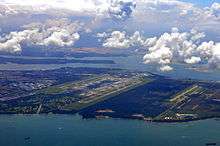
Passenger operations
As the airport only handles international passenger traffic, all terminals in operation are equipped with immigration-processing facilities for international travel.
After recovering from a drop in passenger traffic as a result of the September 11 attacks in 2001 and the severe acute respiratory syndrome (SARS) epidemic in 2003, the airport saw rapid growth in traffic, which hit the 30-million mark for the first time in 2004. In March 2008, prior to the full effect of the financial crisis of 2007–2010 on the global economy, the airport was predicted to handle 50 million passengers by 2012[15] due to the opening of casinos in Singapore and the phased liberalisation of the Asean aviation sector. As predicted, the airport surpassed the 50-million mark in 2012.[11]
On 18 December 2017, the airport surpassed the 60-million mark for the first time.[16][17]
By end-2018, Firefly, the sole turboprop operator in Changi Airport will move to Seletar Airport to make way for their jet operations. [18][19]
Cargo
The Air Cargo Division of the Changi Airport Group (CAG) manages the Changi Airfreight Centre[20] located in the north of the airport premises.[21] The airport handled 1.81 million tonnes of air cargo in 2012, making it the 7th busiest airfreight hub in the world and the fifth busiest in Asia.[22] Due to Singapore's large electronics sector, electrical components constitute a significant part of the total cargo traffic handled at the airport. Changi airport has initiated attempts to expand into the perishable air cargo market. In 2015, Changi Airport handled 1,853,087 tonnes of air freight. Air Cargo World awarded the 2013 Air Cargo Excellence Award to Changi Airport for handling more than 1,000,000 tonnes of cargo in Asia.[23]
The airport handled 2,006,300 tonnes of cargo in 2016, making it the 13th top cargo airport in the world and the sixth in the Asia Pacific region.[24]
In 2017, the airport handled 2,125,226 tonnes of cargo. The top five cargo markets for the airport were China, Australia, Hong Kong, United States and India.[25]
Key markets and destinations
In 2017, Indonesia was the largest market for the airport, followed by Malaysia, China, Thailand, Australia, India, Hong Kong, Philippines, Japan and Vietnam. Kuala Lumpur was the top destination for travellers in the airport, followed by Jakarta, Bangkok, Hong Kong, Manila, Tokyo, Denpasar/Bali, Ho Chi Minh City, Taipei and Sydney.[26]
Safety and security
The Changi Airport Group (CAG) manages the overall safety and security of the airport. The Airport Management Division of the CAG manages the customer aspects of the airport's security, while the Aviation Security Unit oversees the airport's compliance with aviation security (AVSEC) policies, and manages AVSEC-related projects.[21] The airport's emergency and fire-fighting services are handled by the Airport Emergency Service Division.[27] The Airport Emergency Services handles all instances of rescue and fire-fighting within the airport premises as well as in surrounding waters. It operates from two main fire stations (Station 1 by Runway 1 along West Perimeter Road and Station 2 by Runway 2 along Changi Coast Road), one sub-station (Domestic Fire Station), and one sea rescue base near the airport.[28]
The airport's security comes under the regulatory purview of the Airport Police Division of the Singapore Police Force (SPF). The day to day discharge of security functions at the airport are performed by auxiliary police forces including Aetos Security Management, Certis CISCO and SATS Security Services. Aetos and SATS Security Services are affiliated to the ground handling companies of Dnata and Singapore Changi Airport Terminal Services respectively.[29] On 29 April 2008, CAAS signed its then biggest single security contract for all airport related security services by engaging Certis CISCO to provide security services at Singapore Changi Airport, as well as Seletar Airport, Changi Airfreight Centre, and the Singapore Air Traffic Control Centre.[30] It involves the deployment of about 2,600 Certis Cisco personnel, including armed Auxiliary Police Officers and unarmed aviation security officers to perform tasks such as screening checked baggage, controlling access to restricted areas, and screening passengers before they board their aircraft.[31]
Since the 11 September 2001 attacks and the naming of the airport as a terrorism target by the Jemaah Islamiyah, the airport's security has been tightened. Singapore Armed Force and Singapore Police Force officers, armed with assault rifles or sub-machine guns, has been deployed to patrol the terminals at random intervals.[32] Officers from the Gurkha Contingent are also dispatched to patrol the transit areas of the terminal buildings. These measures come at a cost partly borne by travellers in the form of a "passenger security service charge", imposed since 2002.[33]
In 2005, an upgrade in screening technology and rising security concerns led to luggage-screening processes being conducted behind closed-doors, as opposed to them being done before check-in within public view. The screening of carry-on luggage and travellers are mostly conducted at individual departure gates, while check-in luggage are screened in the backrooms and secured before loading. A perimeter intrusion detection system for Changi Airport's perimeter fence has also been put in place to further strengthen security of the airfield, while a biometric access control system for staff movement has been put in place since 2006.
Airlines and destinations
Passenger
.jpg)
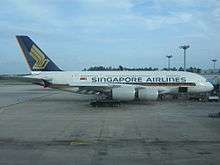
.jpg)
- ↑ Garuda Indonesia flights from Jakarta to Amsterdam on Wednesday, Thursday, and Saturday include a stop-over at Singapore. However, all flights from Amsterdam to Jakarta are nonstop.
Cargo
Operational statistics
.jpg)
.jpg)
.jpg)
| Operational statistics | ||||||||||
|---|---|---|---|---|---|---|---|---|---|---|
| Year | Passenger movements |
Passenger % change over previous year |
Airfreight movements (tonnes) |
Airfreight % change over previous year |
Aircraft movements |
Aircraft % change over previous year | ||||
| 1998 | 23,803,180 | 1,283,660 | 165,242 | |||||||
| 1999 | 26,064,645 | 1,500,393 | 165,961 | |||||||
| 2000 | 28,618,200 | 1,682,489 | 173,947 | |||||||
| 2001 | 28,093,759 | 1,507,062 | 179,359 | |||||||
| 2002 | 28,979,344 | 1,637,797 | 174,820 | |||||||
| 2003 | 24,664,137 | 1,611,407 | 154,346 | |||||||
| 2004 | 30,353,565 | 1,775,092 | 184,932 | |||||||
| 2005 | 32,430,856 | 1,833,721 | 204,138 | |||||||
| 2006 | 35,033,083 | 1,931,881 | 214,000 | |||||||
| 2007 | 36,701,556 | 1,918,159 | 221,000 | |||||||
| 2008 | 37,694,824 | 1,883,894 | 232,000 | |||||||
| 2009 | 37,203,978 | 1,633,791 | 240,360 | |||||||
| 2010 | 42,038,777 | 1,813,809 | 263,593 | |||||||
| 2011 | 46,543,845 | 1,865,252 | 301,711 | |||||||
| 2012 | 51,181,804 | 1,806,225 | 324,722 | |||||||
| 2013 | 53,726,087 | 1,850,233 | 343,800 | |||||||
| 2014 | 54,093,070 | 1,843,799 | 341,386 | |||||||
| 2015 | 55,448,964 | 1,853,087 | 346,334 | |||||||
| 2016 | 58,698,039 | 1,969,434 | 360,490 | |||||||
| 2017 | 62,219,573 | 2,125,226 | 373,201 | |||||||
| Sources:[75][76][77][78][79][80][81] | ||||||||||
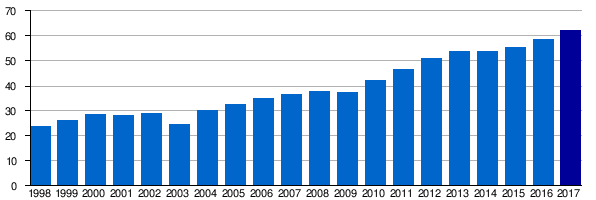 |
| Updated: 4 April 2018 |
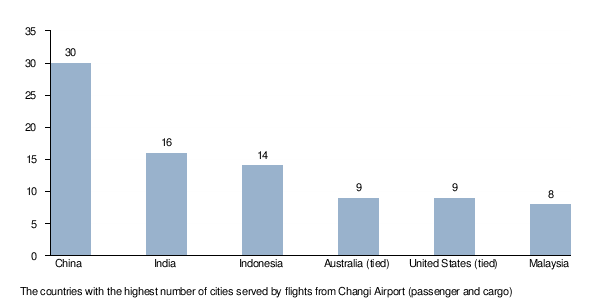
Accidents and incidents
- On 26 March 1991, Singapore Airlines Flight 117, operated by an Airbus A310, was hijacked by four Pakistani terrorists. The flight landed in Changi Airport at 22:15. The Singapore Special Operations Force stormed the plane, on the morning of 27 March. All four hijackers were killed, with no fatalities among the 123 passengers and crew that were held hostage for more than eight hours.
- On 4 November 2010, Qantas Flight 32, operated by an Airbus A380-800, suffered an uncontained engine failure and made an emergency landing in Changi Airport. Upon landing, one of the engines could not be shut down due to ruptured control cables and had to be doused for three hours by airport firefighters to forcefully shut it down. There were no crew or passenger injuries, and all 469 people on board survived this incident.
- On 27 June 2016, Singapore Airlines Flight 368, operated by a Boeing 777-300ER, suffered an engine problem while flying from Singapore to Milan. During the diversionary landing in Singapore, the right engine and wing caught fire. The fire was quickly extinguished by airport fire services. There were no injuries among the 241 people on board.
- On 16 May 2017, a fire broke out at the departure hall in Terminal 2.[82] The fire caused 40 flights at Terminal 2 to be delayed and diverted to Terminal 3.[83] Terminal 2 was closed from 17:30 to 22:45.
- On 29 November 2017, a tow truck towing a Singapore Airlines Boeing 777-200 caught fire, covering the aircraft in black soot. There were no passengers on board when the incident happened and a member of the tow crew was evacuated through the emergency slide.[84]
- On 8 January 2018, a door on a Scoot Boeing 787-8 was partially dislodged after the plane rolled back and impacted an aerobridge. The aircraft, about to undergo maintenance, reportedly had its wheel chocks removed while its brakes were disengaged. No injuries occurred during the incident.[85][86][87]
- On 6 February 2018, a KAI T-50 Golden Eagle which is part of the Black Eagles aerobatic team taking part in Singapore Airshow 2018 veered off the runway during take off. It subsequently crashed and caught fire. The fire was put out by emergency services and the pilot was treated for minor injuries. Runway 1 was closed as a result and caused delays at the airport.[88]
Ground transportation
Changi Airport was built with ground-transportation considerations in mind from the onset, with the East Coast Parkway built and opened in tandem with the airport, providing a direct link to the city-centre. At a distance of about 20 km (12 mi), the expressway was built almost entirely on reclaimed land, thus minimising disruptions to the existing road network in Singapore's East Coast.
Despite the four main passenger terminal buildings being relatively close to each other, the CAAS (Civil Aviation Authority of Singapore) decided to build the Changi Airport Skytrain people-mover system to facilitate quicker and more convenient transfers between the terminals for travellers. The system was upgraded in 2007 to with new technologies supplied by Mitsubishi, connecting to Terminal 3 and separating checked-in passengers from the general public on distinct tracks.
Inter-terminal transportation
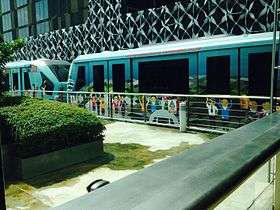

Terminals 1, 2 and 3 are connected by the free Skytrain service, which operates from 05:00 to 02:30. During non-operational hours, travellers in the transit areas may transfer within the terminals by foot via the inter-terminal travellators. For travellers in the public areas, a free shuttle bus service will connect the three terminals.[89]
A complimentary 24-hour Airport Shuttle Bus service plies between Terminal 2 and Terminal 4 in both the public and transit areas. The journey takes approximately eight to 10 minutes.[90]
External connections
Mass Rapid Transit
The airport is connected to the Mass Rapid Transit (MRT) network via a two-stop branch of the East West Line from Tanah Merah MRT Station, consisting of two stations: Expo, serving the nearby Singapore Expo site; and Changi Airport. Changi Airport MRT Station is located underground between Terminal 2 and Terminal 3. A direct, one-train service to the downtown and western parts of Singapore was initially in operation when the station opened on 8 February 2002. This was replaced by the current shuttle service between Tanah Merah and Changi Airport via Expo on 22 July 2003,[91] when it was found that passenger demand for this route was low.
Until Stage 3 of the Downtown Line opened on 21 October 2017, passengers needed to transfer at Tanah Merah station for train service towards the city, Pasir Ris and Tuas Link. However, as of this date, passengers can now transfer at Expo for direct service to Bukit Timah and Bukit Panjang using an alternate route via the city.
Bus
There are seven bus services operated by SBS Transit, SMRT Buses and Go-Ahead Group, making a loop starting from Terminal 3 to Terminal 1, and Terminal 2. Only four bus services will continue to Terminal 4 – Services 24, 34, 36 and 110. Bus stops are located at the basement bus bays of Terminals 1, 2 and 3. For Terminal 4, the bus stop is located next to Car Park 4B.
Coaches to and from Johor Bahru are also available. Operated by Transtar Travel, the service will start at coach stands at Terminals 1, 2, 3 and end at Larkin Terminal.
There is also a free shuttle bus service plying between Changi Airport (T3) and Changi Business Park. This service is a 9-stop route, running from Mondays to Fridays, except public holidays.[92]
Taxi
Taxis are available at taxi stands located in the arrival halls of each terminal. Limousine services are also available. There is an additional airport surcharge for all trips originating from the airport.
Private transport
All pick-ups by private transportation occur at the arrival pick-up points of each terminal.[93][94][95][96]
See also
References
Notes
- ↑ Runway 02L is 4,000 m (13,000 ft) and 20R is 3,260 m (10,700 ft) with a displaced threshold of 740 m (2,430 ft). Thus aircraft landing on 20R will have to avoid touching down on the displaced threshold but may use it for departures.
- ↑ Runway 02R/20L is solely for use by the Republic of Singapore Air Force (see Changi Air Base).[3] It will be available for commercial use in the future
Citations
- ↑ The Official Site of. Changi Airport Group. Retrieved 15 August 2012.
- ↑ "FedEx opens flagship Asia hub". Singapore’s Changi Airport. Aircargonews.net. Retrieved 5 October 2012.
- ↑ "Singapore Changi Airport – Updated Information and Data for Runway 02R/20L" (PDF). AIP Singapore. Civil Aviation Authority of Singapore. 22 June 2018.
- 1 2 3 "Passenger, airfreight & aircraft movements statistics for 2017". Changi Airport Group. 23 January 2018. Retrieved 23 January 2018.
- ↑ "Singapore Changi Airport named as the World's Best Airport". Skytrax. Retrieved 16 March 2016.
- ↑ "The World's Best Airports are announced for 2018". Airport Awards. Skytrax. Retrieved 22 March 2018.
- ↑ "Regulations" (PDF). Caas.gov.sg. Retrieved 3 March 2017.
- ↑ "A billion passengers on, Changi Airport aims higher". The Straits Times. 29 May 2017.
- ↑ "Changi Airport reaches 1 billion passengers milestone". Channel NewsAsia.
- ↑ "accolades – Changi Airport Group". Changi Airport. 23 January 2018. Retrieved 23 January 2018.
- 1 2 "A record 51 million passengers for Changi Airport in 2012" (PDF). Changaiairportgroup.com. Retrieved 3 March 2017.
- ↑ "Changi Airport to open Terminal 4 on Oct 31; 9 airlines to operate from new terminal". The Straits Times. 6 September 2017. Retrieved 25 September 2017.
- ↑ "Changi Airport's Terminal 5 ready in mid-2020s". Yahoo News Singapore. 30 August 2013. Retrieved 10 May 2015.
- ↑ "Changi Airport passengers to pay new levy to fund developments including T5". Channel NewsAsia. 2018-02-28. Retrieved 2018-07-29.
- ↑ "Changi poised to handle 50 million passengers a year by 2012". Channelnewsasia.com. 28 March 2008. Retrieved 8 November 2011.
- ↑ "Flying higher, Changi Airport crosses 60-million milestone in 2017". www.changiairport.com.
- ↑ "Changi Airport hits record 60 million passengers in 2017". Channel NewsAsia.
- ↑ "Seletar Airport Prepares for Turboprop Service". aviationweek.com. Retrieved 5 February 2018.
- ↑ "Singapore 2018: Seletar Airport set for turboprop move". Air & Cosmos – International. Retrieved 6 February 2018.
- ↑ "changi airfreight center". Changi Airport Group. Retrieved 8 November 2011.
- 1 2 "Our Divisions". Civil Aviation Authority of Singapore (CAAS). Archived from the original on 26 September 2006. Retrieved 3 November 2006.
- ↑ Year to date International Freight Traffic. aci.aero
- ↑ "2013 Awards". Air Cargo World. 2013. Archived from the original on 28 August 2013. Retrieved 9 August 2013.
- ↑ "Air Cargo. Still the Cinderella of the airline business – CAPA's top 20 cargo airports". CAPA – Centre for Aviation.
- ↑ "A record 62.2 million passengers for Changi Airport in 2017". www.changiairport.com. Retrieved 23 January 2018.
- ↑ "Top 10 routes from Singapore for 2017". www.changiairport.com. Retrieved 23 January 2018.
- ↑ Changi Airport Group Annual Report 2009/10. (PDF) Retrieved 15 August 2012.
- ↑ "civil fire stations". Changi Airport Group. Retrieved 12 June 2011.
- ↑ "Changi Airport's third ground handling licence awarded to ASIG". Channel NewsAsia. 9 June 2011. Retrieved 8 November 2011.
- ↑ "Certis CISCO awarded $360 million Master Security Services Contract by CAAS". Certissecurity.com. 28 April 2008. Archived from the original on 2 October 2011. Retrieved 8 November 2011.
- ↑ 50 Years of Securing Your World Archived 8 July 2011 at the Wayback Machine.. Annual Review 2008/2009. certissecurity.com (PDF). Retrieved 15 August 2012.
- ↑ "Counter Terrorism Efforts at Singapore's Changi Airport". South Asia Analysis Group. Archived from the original on 12 June 2010. Retrieved 12 June 2011.
- ↑ "Changi Airport to Impose Security Levy". Straits Times. Singapore. 10 January 2002. Archived from the original on 2 September 2006. Retrieved 3 November 2006.
- ↑ "Air India Express adds Bangalore – Singapore from late-Oct 2018". Routesonline. 2018-09-28. Retrieved 2018-10-02.
- ↑ "China Southern resumes Shenzhen – Singapore from July 2018". Routesonline. Retrieved 14 May 2018.
- ↑ "Emirates to suspend two flights between Singapore and Colombo". The Daily Mirror. Retrieved 15 August 2018.
- ↑ 2018, UBM (UK) Ltd. "Garuda Indonesia NW18 Amsterdam service changes". Routesonline.
- ↑ "Guangxi Beibu Gulf files Singapore preliminary schedule in S19". Routesonline. Retrieved 4 September 2018.
- ↑ "IndiGo schedules" (PDF). goindigo.in. Retrieved 2018-10-02.
- ↑ "IndiGo Vijayawada Singapore launch delayed". timesofindia.indiatimes.com. 2018-10-02. Retrieved 2018-10-02.
- ↑ https://timesofindia.indiatimes.com/city/pune/jet-to-start-direct-singapore-flight-from-december-1/articleshow/66173408.cms
- ↑ "Jetstar Asia Will Soon Have Direct Flights Between Singapore and Clark, Pampanga". tripzilla.com. Retrieved 25 September 2017.
- ↑ "Jetstar launches direct flights from Singapore to Hat Yai". Channel NewsAsia. Retrieved 25 September 2017.
- ↑ "Direct connection to Singapore". www.lot.com.
- ↑ 2017, UBM (UK) Ltd. "LOT Polish Airlines resumes Singapore service from May 2018". Routesonline.
- ↑ "Malindo Air adds scheduled Kota Kinabalu – Singapore service from August 2018". routesonline. Retrieved 24 July 2018.
- ↑ Noakes, Gary (7 September 2018). "Norwegian to ditch Gatwick-Singapore but add Rio". TTG Media Limited. Retrieved 7 September 2018.
- ↑ "Qantas ditches Dubai, returns A380 to Sydney-Singapore-London". Australian Business Traveller. Retrieved 31 August 2017.
- ↑ "New long to Singapore". Berlin Brandenburg Airport.
- ↑ 2018, UBM (UK) Ltd. "Scoot plans Berlin launch in June 2018". Routesonline.
- ↑ "SilkAir flight MI884". Flightradar24.
- ↑ "SilkAir flight MI883". Flightradar24.
- ↑ "Singapore Airlines To Launch World's Longest Commercial Flights". www.singaporeair.com. Retrieved 30 May 2018.
- ↑ "United adjusts Singapore service from late-Oct 2018". Routesonline. Retrieved 2018-07-29.
- ↑ "AirBridgeCargo Airlines debuts at Singapore Changi Airport with direct freighter flights from Moscow".
- ↑ "AirBridgeCargo is on its way developing services in Asia | Company news | Media Centre | AirBridgeCargo". airbridgecargo.com. Archived from the original on 12 July 2016.
- ↑ "Air HongKong". Retrieved 10 May 2015.
- ↑ "ANA Cargo International Timetable & Connections" (PDF). ANA Cargo.
- ↑ "Cardig Air Scheduled Timetable". Cardigair.com. Retrieved 1 January 2014.
- ↑ "2013 summer schedule". Aero Logic. Retrieved 13 August 2013.
- ↑ "Polar Air Cargo Worldwide launches new freighter service to Singapore" (PDF). Changaiairportgroup.com. Retrieved 3 March 2017.
- ↑ "Emirates SkyCargo Freighter Operations get ready for DWC move". Emirates SkyCargo. 2 April 2014.
- ↑ "Etihad Cargo Flight Schedule" (PDF). Archived from the original (PDF) on 26 April 2014.
- ↑ "Etihad Cargo operates Boeing 777F to Singapore" (PDF). Archived from the original (PDF) on 19 October 2013.
- ↑ "EVA Air flight BR6052". Flightradar24.
- ↑ "EVA Air Cargo Flight Schedule" (PDF). www.evaair.com.
- ↑ "Hong Kong Airlines Cargo". Retrieved 10 May 2015.
- ↑ "K – Mile Asia". www.k-mile.com.
- ↑ "New Route From Surabaya to Singapore". My Indo Airlines. Retrieved 29 January 2015.
- ↑ "Neptune Air". www.neptuneair.com.
- ↑ "Silk Way West Airlines flight 7L633". Flightradar24.
- ↑ "Silk Way West Airlines flight 7L634". Flightradar24.
- ↑ "Silk Way West Airlines flight 7L671". Flightradar24.
- ↑ "Singapore Airlines Cargo to commence Singapore-Hanoi freighter service in Nov-2014". CAPA. 14 November 2014. Retrieved 14 November 2014.
- ↑ "2011 Singapore Changi Airport Statistics" (PDF). Changi Airport Group. Changi Airport Group. 20 January 2012. Archived from the original (PDF) on 17 April 2016. Retrieved 30 March 2016.
- ↑ "2012 Singapore Changi Airport Statistics" (PDF). Changi Airport Group. Changi Airport Group. 31 January 2013. Archived from the original (PDF) on 17 April 2016. Retrieved 30 March 2016.
- ↑ "2013 Singapore Changi Airport Statistics" (PDF). Changi Airport Group. Changi Airport Group. 28 January 2014. Archived from the original (PDF) on 1 July 2014. Retrieved 30 March 2016.
- ↑ "2014 Singapore Changi Airport Statistics" (PDF). Changi Airport Group. Changi Airport Group. 29 January 2015. Retrieved 30 March 2016.
- ↑ "2015 Singapore Changi Airport Statistics". Changi Airport Group. Changi Airport Group. 27 January 2016. Retrieved 30 March 2016.
- ↑ "2016 Singapore Changi Airport Statistics". Changi Airport Group. Changi Airport Group. 30 January 2017. Retrieved 30 January 2017.
- ↑ "2017 Singapore Changi Airport Statistics". Changi Airport Group. Changi Airport Group. 23 January 2018. Retrieved 23 January 2018.
- ↑ "'Small fire' at Changi Airport T2 sparks evacuation, flight delays". Channelnewsasia.com. Retrieved 16 May 2017.
- ↑ "Changi Airport fire: About 40 flights affected by Terminal 2 closure". Channelnewsasia.com. Retrieved 17 May 2017.
- ↑ "Tow tug at Changi Airport catches fire while towing SIA plane". Channel NewsAsia. Retrieved 29 November 2017.
- ↑ "Scoot's plane door damaged after bumping aerobridge at Changi Airport". Channel NewsAsia. 8 January 2018. Retrieved 16 January 2018.
- ↑ "Door of Scoot aircraft damaged during maintenance at Changi Airport". Yahoo News Singapore. 8 January 2018. Retrieved 16 January 2018.
- ↑ "9V-OFI Scoot Boeing 787-8 Dreamliner". www.planespotters.net. Retrieved 6 February 2018.
- ↑ "Korean plane taking part in Singapore Airshow crashes, catches fire at Changi Airport; flight delays expected". Channel News Asia. 6 February 2018. Retrieved 6 February 2018.
- ↑ "Transfer Between Terminals". www.changiairport.com. Skytrain.
- ↑ "Transfer Between Terminals – Terminal 4 Shuttle Bus". www.changiairport.com.
- ↑ "Singapore MRT (Metro)". UrbanRail.Net. Retrieved 18 April 2007.
- ↑ "Shuttle Services". www.changiairport.com.
- ↑ "Private Transport Pick-up". www.changiairport.com.
- ↑ "Your Changi Airport Guide". Grab SG. Retrieved 18 November 2016.
- ↑ "Request Uber at Singapore Changi International Airport (SIN)". www.uber.com.
- ↑ "Instructions For Drivers At Changi Airport". www.uber.com.
Bibliography
- Winchester, Clarence, ed. (1938), "Singapore's great airport", Wonders of World Aviation, pp. 128–130 , illustrated description of the newly opened Singapore Airport
External links
| Wikivoyage has a travel guide for Singapore Changi Airport. |
| Library resources about Singapore Changi Airport |
![]()